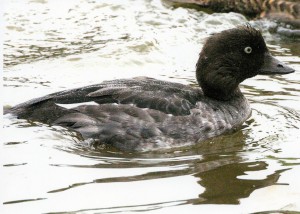 With the general countryside now often frozen many of the birds that frequent the rivers and burns and any inland waters are likely to head for the coast. Fortunately around Inverness there are some extremely good vantage points to see not only these birds but also others such as ducks and geese that are here only for the winter months. Some of these will have travelled long distances, such as the geese or many of the ducks. The whooper swans, mentioned in this column last week, are a good example as they will have their breeding grounds mainly in Iceland. One of the commonest of the wintering ducks is the wigeon that sometimes flock in very large numbers in the firths and these will mainly have bred in Iceland and Northern Europe. Some stay for the summer with about 400 pairs nesting, mainly in the Highlands, whilst the wintering numbers can be as high as 96,000 birds!
With the general countryside now often frozen many of the birds that frequent the rivers and burns and any inland waters are likely to head for the coast. Fortunately around Inverness there are some extremely good vantage points to see not only these birds but also others such as ducks and geese that are here only for the winter months. Some of these will have travelled long distances, such as the geese or many of the ducks. The whooper swans, mentioned in this column last week, are a good example as they will have their breeding grounds mainly in Iceland. One of the commonest of the wintering ducks is the wigeon that sometimes flock in very large numbers in the firths and these will mainly have bred in Iceland and Northern Europe. Some stay for the summer with about 400 pairs nesting, mainly in the Highlands, whilst the wintering numbers can be as high as 96,000 birds!
There are many places to see all these birds gathered along the coast with the well known ones being Udale Bay and Nigg Bay where the RSPB have their hides that are open to the public all the year round. Loch Fleet, further up the east coast, is well worth visiting and along that coast, but much closer, is the dramatic peninsular of Tarbet Ness. Another good place is Burghead or Findhorn along the east coast from Inverness. One place that is often overlooked, but is only a very short distance away, is Alturlie Point, only a few miles east of Inverness. There may be no hides there but there are vantage points along the narrow road for some superb and very rewarding bird-watching. There are one or two pull-off points, as opposed to passing places, where the car can be used as a hide without disturbing the birds at all.
Last week I took the camera along to Alturlie Point and was rewarded with a good selection of birds scattered along the coastline. Unfortunately the tide was not right for the best bird watching but there was plenty to see. The best time to visit such coastal sites is when the tide is either going out or on the way in . The birds, especially if the tide is ebbing, will use every small area of the slowly exposed mud to feed, stacking away enough food for when the next tide turns. The mud or sand banks are very rich in food and the various waders have evolved different length beaks to take advantage of the differing foods. At the one extreme is the curlew which obviously feeds at different levels in the mud than the lapwings.
On my visit there were large numbers of ducks spread, apparently at random, over the very large expanse of water as the tide was well in. At first there seemed to be no pattern to this spread of birds but a closer view through binoculars gave an idea where to look. The bulk of the birds were well scattered and this proved to be a mixture of a few hundred wigeon and scaup. At first view that seemed to be all, but then subtle differences could be seen. Just on the seaward edge of the birds there was a small dense pack of about thirty birds and they were mallard. An even smaller group just away from the rest were very small ducks and, as expected, there were the diminutive teal. The single goldeneye was on its own but just as interesting. A rich assemblage of birds with Inverness so close
